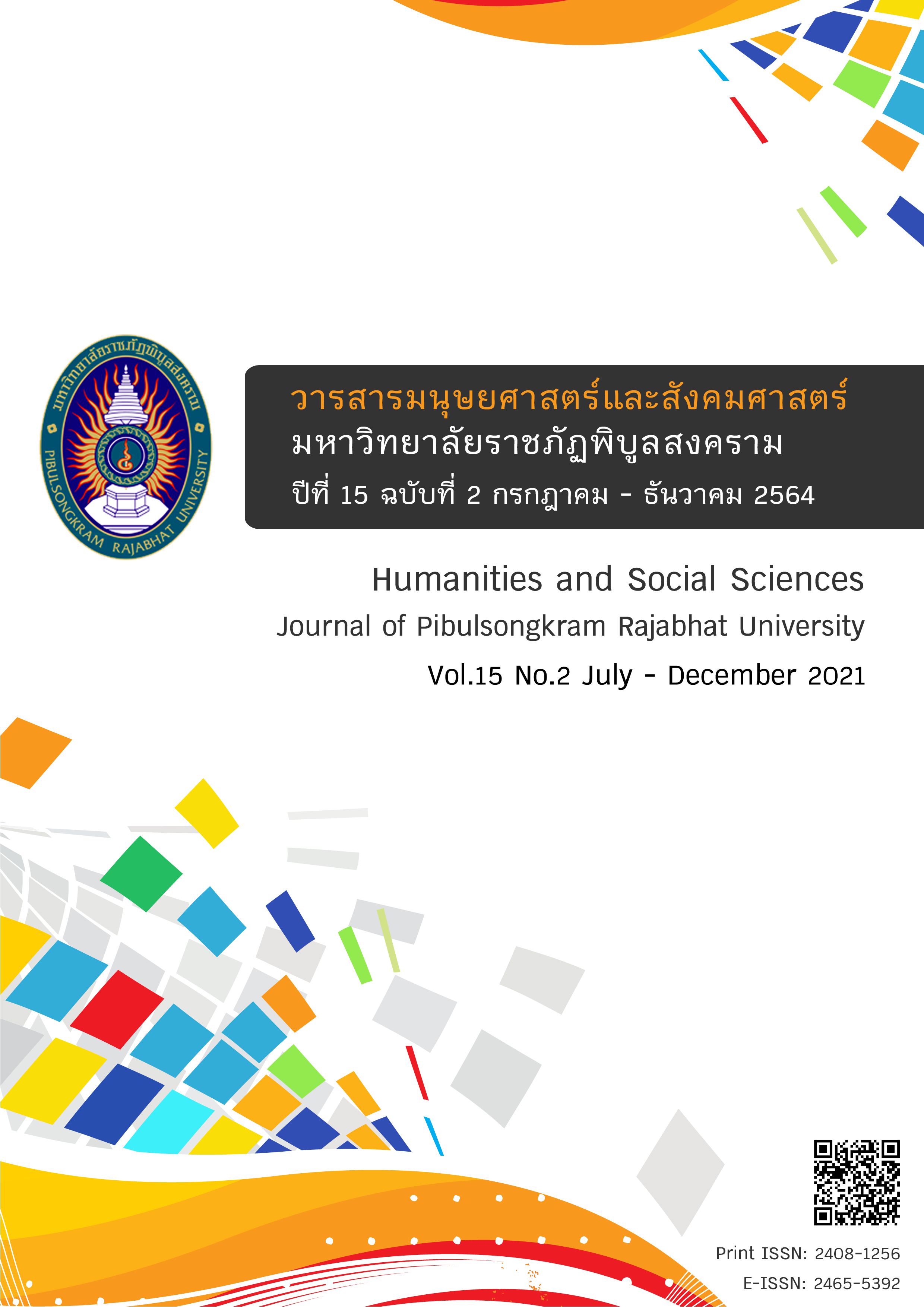A Study of the Needs Conditions for Development of a Combined Model of Active Proactive Learning with KWDL Techniques to Enhance Mathematical Problem Solving Skills for Junior High School Students
DOI:
https://doi.org/10.14456/psruhss.2021.36Keywords:
Needs, Active Proactive, KWDL TechniquesAbstract
The purpose of this research was to study the needs development of a combined model of active proactive learning with KWDL techniques to enhance mathematical problem solving skills. The samples were 180 mathematics teachers teaching Junior High School students in Secondary Educational Service Area Office 41. They were selected by using Taro Yamane formula with 95% confidence level with Multi - state Random Sampling by the sizes of schools: large, medium or small. The instruments used were questionnaires about the needs development of a combined model of active proactive learning with KWDL techniques to enhance mathematical problem solving skills and analyzed using frequency, percentage, mean (), standard deviation (S.D.) and Modified Priority Needs Index by using Modified Priority Need Inbox Technique. The results of this research were as follows: real conditions of a combined model of active proactive learning with KWDL techniques to enhance overall mathematical problem solving skills were in a high level and practice conditions of the teachers had the highest level of active proactive learning with KWDL techniques to enhance overall mathematical problem solving skills.
References
กระทรวงศึกษาธิการ. (2551). หลักสูตรแกนกลางการศึกษาขั้นพื้นฐานพุทธศักราช 2551. กรุงเทพฯ: กระทรวงศึกษาธิการ.
กระทรวงศึกษาธิการ. (2560). ตัวชี้วัดและสาระการเรียนรู้แกนกลางกลุ่มสาระการเรียนรู้คณิตศาสตร์ (ฉบับปรับปรุง พ.ศ. 2560). กรุงเทพฯ: ชุมชนสหกรณ์การเกษตรแห่งประเทศไทย.
ทิศนา แขมมณี. (2551). ศาสตร์การสอน องค์ความรู้เพื่อการจัดกระบวนการการเรียนรู้ที่มีประสิทธิภาพ. กรุงเทพฯ: จุฬาลงกรณ์มหาวิทยาลัย.
ทิศนา แขมมณี. (2557). 14 วิธีสอนสำหรับครูมืออาชีพ. กรุงเทพฯ: จุฬาลงกรณ์มหาวิทยาลัย.
นนทลี พรธาดาวิทย์. (2559). การจัดการเรียนรู้แบบ Active learning (พิมพ์ครั้งที่ 2). กรุงเทพฯ: ทริปเพิ้ล เอ็ดดูเคชั่น.
นิรันดร์ แสงกุหลาบ. (2547). การเปรียบเทียบผลการเรียนรู้ เรื่อง โจทย์ปัญหาทศนิยมและร้อยละของนักเรียนชั้นประถมศึกษาปีที่ 5 ที่จัดการเรียนรู้ ด้วยเทคนิค K-W-D-L และตามแนว สสวท. (วิทยานิพนธ์ปริญญามหาบัณฑิต). นครปฐม: มหาวิทยาลัยศิลปากร.
ภัทร์พงศ์ พงศ์ภัทรกานต์. (2553). การพัฒนารูปแบบการเรียนรู้แบบร่วมมือ โดยใช้เทคนิคทีเคโอ (วิทยานิพนธ์ปริญญาปรัชญาดุษฎีบัณฑิต). กรุงเทพฯ: มหาวิทยาลัยเทคโนโลยีพระจอมเกล้าพระนครเหนือ.
ฤธาพร ฤทธิเรืองเดช. (2558). การจัดการเรียนรู้แบบกลุ่มผลสัมฤทธิ์ STAD ร่วมกับเทคนิค KWDL เรื่องการประยุกต์ของสมการเชิงเส้นตัวแปรเดียว สำหรับนักเรียนชั้นมัธยมศึกษาปีที่ 2 (วิทยานิพนธ์ปริญญามหาบัณฑิต). พิษณุโลก: มหาวิทยาลัยนเรศวร.
วัชรา เล่าเรียนดี. (2547). เทคนิคการจัดการเรียนรู้สำหรับครูมืออาชีพ. นครปฐม: มหาวิทยาลัยศิลปากร.
วาสนา เจริญไทย. (2557). ผลการจัดการเรียนรู้เชิงรุกที่มีผลต่อผลสัมฤทธิ์ทางการเรียนและความสามารถในการแก้ปัญหาทางคณิตศาสตร์ เรื่อง เศษส่วน ของนักเรียนชั้นมัธยมศึกษาปีที่ 1 (วิทยานิพนธ์ปริญญามหาบัณฑิต). ชลบุรี: มหาวิทยาลัยบูรพา.
วีระศักดิ์ เลิศโสภา. (2544). ผลของการใช้เทคนิคการสอน KWDL ที่มีผลสัมฤทธิ์ในการแก้โจทย์ปัญหาคณิตศาสตร์ของนักเรียนชั้นประถมศึกษาปีที่ 4 (วิทยานิพนธ์ปริญญามหาบัณฑิต). กรุงเทพฯ: มหาวิทยาลัยศรีนครินทรวิโรฒ.
สถาบันทดสอบทางการศึกษาแห่งชาติ (องค์การมหาชน). (2560). รายงานประจำปี 2560. กรุงเทพฯ: สถาบันทดสอบทางการศึกษาแห่งชาติ (องค์การมหาชน).
สถาบันส่งเสริมการสอนวิทยาศาสตร์และเทคโนโลยี. (2555). ทักษะและกระบวนการทางคณิตศาสตร์ (พิมพ์ครั้งที่ 3). กรุงเทพฯ: 3 - คิว มีเดีย.
สำนักงานเลขาธิการสภาการศึกษา. (2560). แผนการศึกษาแห่งชาติ พ.ศ. 2560-2579 (พิมพ์ครั้งที่ 2). กรุงเทพฯ: สำนักงานเลขาธิการสภาการศึกษา.
Bonwell, C. C., & Eison, J. A. (1991). Active Learning: Creating Excitement in the Classroom. Washington, DC: ERIC Clearinghouse on Higher Education, George. Washington University.
Haack, K. (2008). UN studies and the curriculum as active learning tool. International Studies Perspectives Journals, 9(1), 395-410.
Thaman, R., Dhillon, S., Saggar, S., Gupta, M., & Kaur, H. (2013). Promoting active learning in respiratory physiology – Positive student perception and improved outcomes. Natl J Physiol Pharm Pharmacol, 3(1), 27-34.
Yamane, T. (1973). Statistics: An Introductory Analysis. New York: Harper and Row Publications.
Downloads
Published
How to Cite
Issue
Section
License
Any articles or comments appearing in the Journal of Humanities and Social Sciences, Rajabhat Phibulsongkram University, are the intellectual property of the authors, and do not necessarily reflect the views of the editorial board. Published articles are copyrighted by the Journal of Humanities and Social Sciences, Rajabhat Phibulsongkram University.









